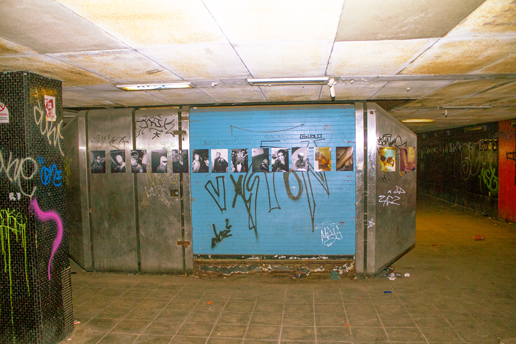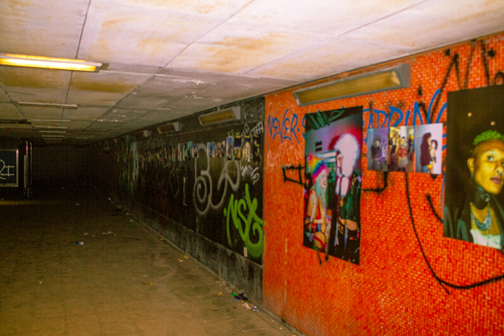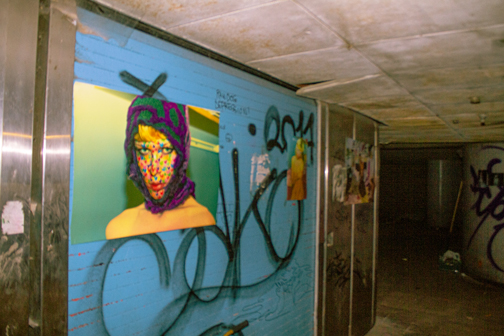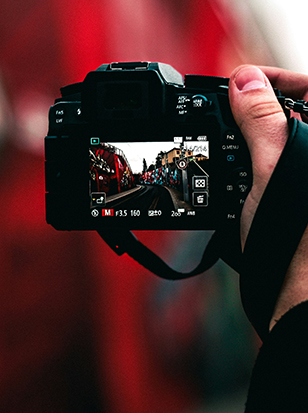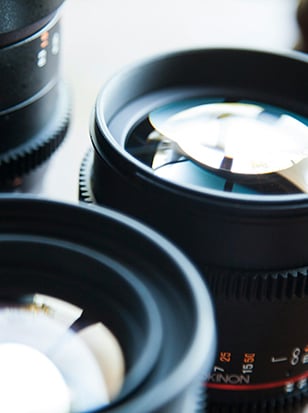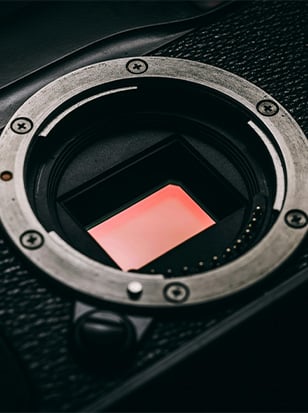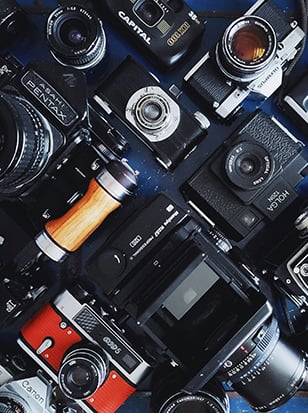
You may have been to a few photo exhibitions, but it’s likely you’ve never been to one quite like those put on by Mia Evans. The London-based photographer has carved out a niche organising a type of event that could best be described as ‘exhibition-slash-rave’, displaying her images on the walls of all-night parties with DJ’s blasting out tunes until the early hours of the morning. You don’t get that at the V&A.
Evans’ work is stylish and eclectic, blending experimental and conceptual portraiture with documentary-style images of the rave scene. The exhibitions began as a makeshift impromptu show in a stairwell, but have since expanded to bigger events in London’s most popular venues. For Evans, it’s not just a chance for a party — it’s also an opportunity to provide a platform for trans and queer artists like herself, and for music and photography to combine to create a multi-sensory, multi-layered experience that goes beyond simply being art on a wall.
It’s a fascinating fusion of forms — and I was thrilled to be able to catch up with Mia to learn a little more about it…
Jon Stapley: How did the idea come about for combining photography exhibitions and raves in the way you have – what inspired it initially?
Mia Evans: When I first moved to London, as an 18-year-old trans girl from Northampton, I found solitude and community in the underground queer rave scene, and started photographing my experience and those who attended the raves.
My rave photography is what I describe as a reactionary process: the photos are made to replicate the emotive experience of raving, responding to the colour, the music of the spaces, the fashion of the attendees and the queerness of the whole affair. While the photographs were to immortalise the experience and the queer and transgender attendees, they also served purpose in immersing the viewer into the rave.
For my first exhibition, “So Far”, it started as a display in my accommodation stairwell, as a way to present my work after being temporarily banned from Instagram. Prioritising work being viewed physically, compared to an online space. I believe the idea to turn the exhibition into a rave was from my friend Henrique. The purpose was to not only create a further space for queer and transgender people to rave, but to add a further layer to the photographs.
By placing photographs of raves, taken with the reactionary process, back into a rave space, the viewer could be further immersed into the photograph with the soundtrack and environment to accompany it.
The first exhibition rave was a free party, to make the event and photography accessible to all, in an abandoned tunnel in Edgware Road, which is now filled with cement. Nine out of the ten DJs identified as Trans*, which allowed for the further platforming of transgender artistry apart from my own, and that was the goal really, to make raving and art available to anybody who wanted to come.
JS: What do you love about photo exhibitions and raves, and how do you feel the two experiences complement one another?
ME: What I love about photography exhibitions is the ability to actually engage with the work in a way that sparks thought, compared to mindless scrolling on a phone. Also, my work outside of the rave scene contains a lot of nudity, and that’s not something that can be posted onto Instagram, so it allows for all kinds of work to be viewed in full.
Exhibitions allow for the viewer to be immersed into the world of the photographer, and raves allow the attendee to be immersed into the musical world of the DJ. Photography itself restricts the world into only the visual sense, and so by accompanying an exhibition with the soundtrack and actual environment of the photographs, it allows for raves to be experienced on a multi-sense level.
I feel that exhibitions often lack a dimension of sensory stimulation, and as a neurodivergent person, in a community with lots of other neurodiverse people who often go to raves seeking stimulation, the exhibition/rave can become a sensory dream-scape. I think this is why other forms of artistry, such as performance art, accompany raves so well – it adds a depth of world-building that is perhaps lacking when the music or the art exists solely by itself.
I also love the community-forming that happens within rave spaces, and of course the music, and so bringing this together with my love for photography felt so right.
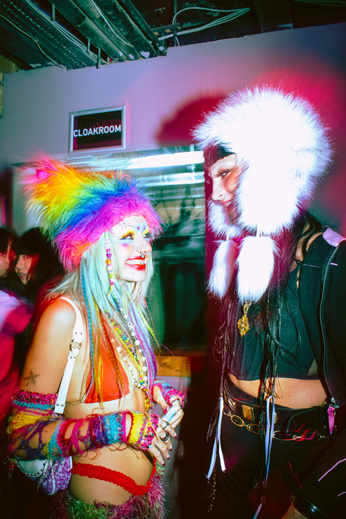
JS: What kind of responses have you had from attendees? I would guess (correct me if I'm wrong) that plenty of people attend who don't otherwise go to many photography exhibitions. Have any responses surprised you?
ME: The first exhibition rave happened in January of 2023. To this day I still have people approach me at raves who tell me how much they enjoyed that night. And I suppose, due to that ever-present feeling of self-doubt, the fact that they have held onto that memory is the biggest surprise.
Also the fact that for many people I’ve met, that was the first rave they ever went to — I think being introduced to the rave scene at a rave that also reflected on raving is a crazy, but beautiful, introduction to the scene. People have responded very well to the events, and express their want for more. I’ve also had older ravers really appreciate the fact that I have immortalised the community and the events themselves, the importance of documenting the existence of transgender and queer people in expressive spaces, during times of subordination.
I just want my work, and the way it is engaged with, to have an impact. And I feel that even if it’s just to a select group of people, it already has (I hope).
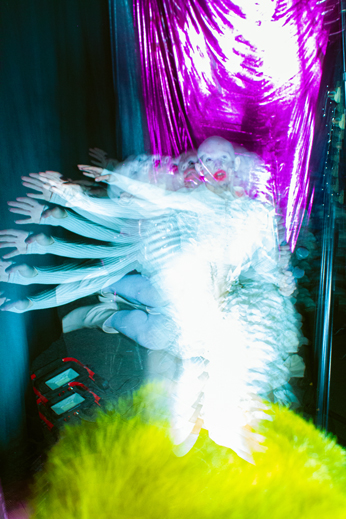
JS: You've put on a few of these exhibitions now. How have the format and your approach evolved or changed?
ME: The first exhibition rave was a display of the photographic work that I had made so far in my life, a mixture of still-life, portraits and of course, rave documentation. The second exhibition was a photobook-release rave in May of 2023, for my book “Reality and Very Existence” [R.A.V.E]. The photobook consisted primarily of rave photographs with nude self-portraits and other queer portraiture, and the photographs displayed were reflecting and expanding upon what was in the book.
The third exhibition rave, “The Seen”, in August of the same year, was held in a warehouse space and was more dialled back, displaying a “best of” the work shown from the previous two exhibitions, focusing more on rave documentation and a few self-portraits. A year later, in August of 2024, I held “Roaring Twenties”, a celebration of my 20th birthday and documentation of the current decade (the 20s) at Islington Arts Club while I was working there.
This was the first time holding an exhibition/rave at a legal venue. These images were mostly unseen, with a few favourites from previous exhibitions making a return. As the exhibition moved away from the rave environment, still accompanied however by the same music, the photos were placed as such. In the first half of the space were lots of rave photographs, and further down the space were self-portraits and nudes in the garden.
Since then I have not held my own exhibition, though I have exhibited with rave organisers PMAD, a mix of rave photographs and more conceptual self-portraiture such as a large wall filled with A4 scans of my nude body. I feel as my practice has moved slightly further away from the rave scene, so has the way that the photographs are exhibited. But I would like to return to my roots, perhaps mixing more fine-art based work — which I’m working on currently — with the rave environment. I feel that the immersion of rave photographs in a rave setting is unmatched, but non-rave work can work well in unity with the music, given the emotions it’s intended to convey.
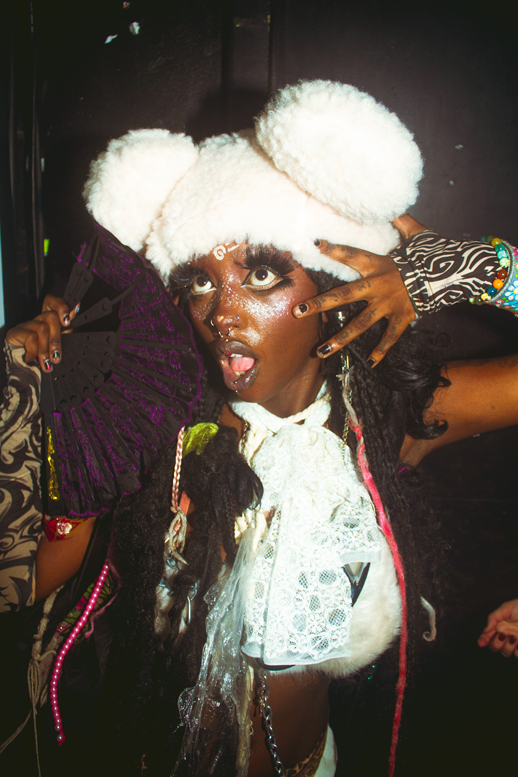
JS: Do you have plans for any future exhibitions at the moment?
ME: Well, I’m now coming up to my graduation show, part of Photography at Westminster, [6th June at Ambika P3, Westminster University Marylebone Campus], in which I’m not displaying rave documentation, but rather emotive self-portraiture documenting mental processing after sexual assault.
But I do have hopeful plans for another exhibition rave. Rather than only presenting my work, I want to curate a huge show of as many London queer rave photographers as I can, accompanied by several rooms of DJs. With this, I want to properly publish a big anthology book, with photos, reflections and theorisations putting rave photography into an artistic context, but this will take me quite a while to do, I feel.
To see more of Mia Evans’ work, follow her on Instagram @ahgeewiz.
About the Author
Jon Stapley is a London-based freelance writer and journalist who covers photography, art and technology. When not writing about cameras, Jon is a keen photographer who captures the world using his Olympus XA2. His creativity extends to works of fiction and other creative writing, all of which can be found on his website www.jonstapley.com
Sign up for our newsletter today!
- Subscribe for exclusive discounts and special offers
- Receive our monthly content roundups
- Get the latest news and know-how from our experts

